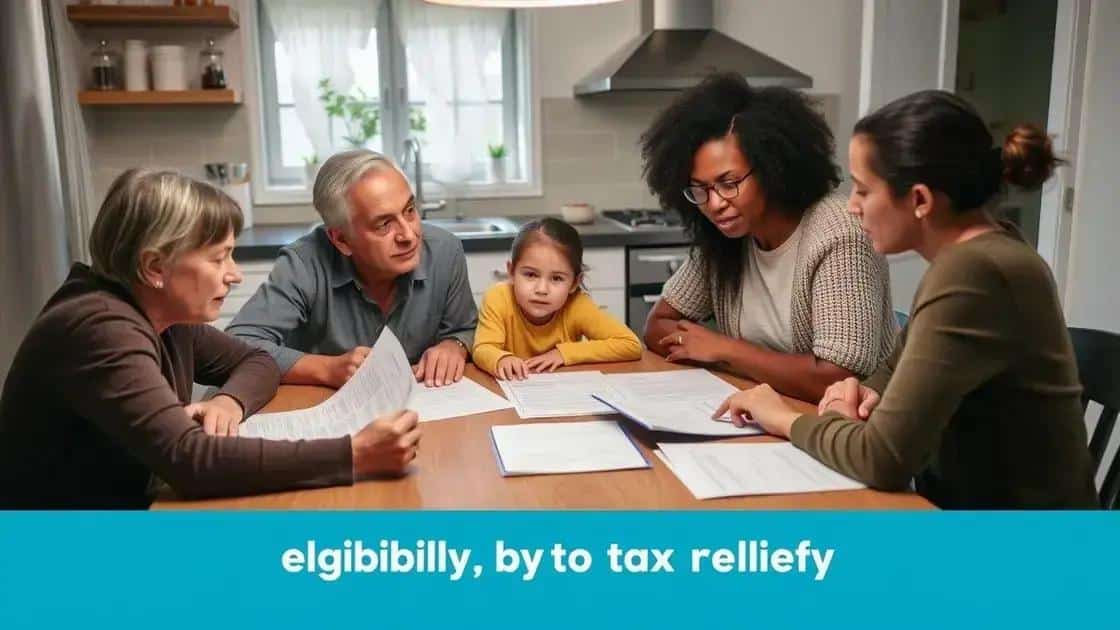Tax relief for low-income families: how to access benefits

Tax relief for low-income families provides essential financial aid through credits and deductions, improving their budget by reducing tax liabilities and increasing disposable income for essential needs.
Tax relief for low-income families offers crucial support, helping to ease the financial burden many face. Have you ever wondered how these benefits could change your financial situation? Let’s explore the options available to you.
Understanding tax relief options
Understanding the tax relief options available is essential for low-income families seeking financial help. Tax relief can provide significant assistance, reducing tax burdens and allowing families to keep more of their hard-earned money.
Types of Tax Relief can include credits, deductions, and various assistance programs. Knowing the right options can be a game changer. Many families feel overwhelmed by these choices, but a clear understanding can make the process smoother.
Tax Credits
Tax credits directly reduce the amount of tax owed. For families with lower incomes, the Earned Income Tax Credit (EITC) is particularly beneficial. This credit can provide thousands of dollars back in tax refunds, depending on your earnings and the number of children you have.
Deductions and Exemptions
Deductions lower the amount of income that is taxable. Common deductions include expenses related to education, homeownership, or certain medical expenses. Additionally, personal exemptions allow you to reduce your taxable income based on the number of dependents you claim.
Assistance Programs
There are various assistance programs available that can help families receive tax relief. Programs like the Temporary Assistance for Needy Families (TANF) or Supplemental Nutrition Assistance Program (SNAP) provide financial help and can influence your tax situation positively.
Understanding these tax relief options is just the start. Each family’s financial situation is unique, which makes it wise to consult a tax professional if you feel uncertain or need tailored advice. The goal is to maximize your benefits and relieve financial pressure.
Eligibility criteria for low-income families

Eligibility criteria for low-income families seeking tax relief can vary, but several key factors determine who qualifies. Understanding these criteria is crucial to accessing available benefits.
Generally, your household income plays a significant role in determining your eligibility. This income is assessed against federal poverty guidelines, which are updated annually. Families with incomes below a certain threshold can often qualify for various programs and benefits designed to provide financial assistance.
Key Factors in Determining Eligibility
Other criteria besides income can include:
- The number of dependents in your household
- Your filing status, such as single, married, or head of household
- Citizenship and residency requirements
Furthermore, specific programs may have additional requirements that families need to meet. For example, the Earned Income Tax Credit (EITC) requires you to have earned income through employment or self-employment to qualify. It’s essential to maintain documentation regarding your income sources and family composition, as this information can be vital when applying for tax relief.
Every state may also have its own eligibility guidelines for local assistance programs. Researching these regulations can provide even more options for low-income families in need of support. Overall, it is advisable to explore all available resources to maximize your eligibility for financial assistance.
How to apply for tax relief benefits
Applying for tax relief benefits can seem daunting, but with clear steps, families can navigate the process more easily. Knowing where to start and what documents are needed can save time and reduce stress.
Begin by gathering all necessary documents. This includes your previous year’s tax returns, proof of income, and any forms specific to the tax relief program you are applying for. These documents help demonstrate your eligibility and support your application.
Steps to Apply
The application process typically involves:
- Filling out the appropriate tax forms for tax relief benefits.
- Submitting your application by the deadline, which is usually during tax season.
- Providing supporting documents, such as proof of income and family size.
It’s crucial to follow all instructions carefully. Missing information can lead to delays or denials. Consider checking the website of the taxing authority for instructions specific to your state or program.
Once submitted, you can track the status of your application. Some programs provide online portals where you can check updates. Staying informed is key to ensuring your application is processed smoothly.
If you need assistance, don’t hesitate to reach out for help. Organizations such as local community centers often provide free resources or workshops to help families apply for tax relief. They can offer personalized guidance and answer any questions you may have.
Impact of tax relief on family budgets

The impact of tax relief on family budgets can be profound, altering financial flexibility and overall well-being. For many low-income families, tax relief means the difference between financial stability and ongoing struggle.
When families receive tax refunds or lower tax bills, they often redirect these funds towards essential needs. This can include paying for groceries, medical expenses, and housing costs. Understanding how these benefits work helps families make informed decisions about their finances.
Positive Financial Outcomes
Here are some potential benefits of tax relief:
- Increased disposable income for day-to-day expenses.
- The ability to pay down debt more quickly.
- Enhanced savings for emergencies.
Families can also use extra funds for education or childcare, leading to long-term benefits. Investing in these areas can improve the quality of life and open up new opportunities for children.
However, the impact of tax relief isn’t just financial. It can also reduce stress and anxiety related to money. When families feel more secure in their finances, it can positively affect their overall mental well-being. With reduced financial worry, families often report improved relationships and a sense of community.
It’s important to recognize that not everyone will experience the same benefits. Each family’s situation is unique, and factors such as income level and specific tax credits can influence the extent of relief. By staying informed about how to maximize these benefits, families can better navigate their financial futures.
In conclusion, understanding tax relief can have a positive impact on low-income families. By knowing the available options and eligibility criteria, families can navigate the application process more effectively. The benefits of tax relief extend beyond financial savings, as they can improve overall well-being and reduce stress. By utilizing these resources wisely, families position themselves for a more secure and prosperous future.
FAQ – Frequently Asked Questions about Tax Relief for Low-Income Families
What is tax relief for low-income families?
Tax relief refers to various programs and credits that reduce the tax burden on families with lower incomes, helping to ease financial stress.
Who qualifies for tax relief benefits?
Eligibility typically depends on household income, number of dependents, and specific program requirements.
How can tax relief impact a family’s budget?
Tax relief can increase disposable income, allowing families to spend more on essentials, save for emergencies, and reduce financial stress.
What steps should families take to apply for tax relief?
Families should gather necessary documents, fill out application forms, and submit them by the deadline, ensuring all requirements are met.






